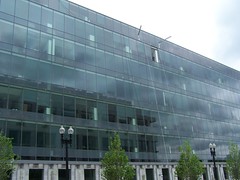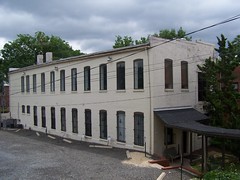A lesson in "intensification of land use"* from Dreyfus Corporation
strat·a·gem n. (Definition from answers.com)
1. A military maneuver designed to deceive or surprise an enemy.
2. A clever, often underhanded scheme for achieving an objective.
 Station Place, 2nd Street NE, rendering from the developer.
Station Place, 2nd Street NE, rendering from the developer.A group of us citizen advocates from around the city (Foggy Bottom, Friendship Heights, H Street) trade notes about the corruption of the PUD process. I have stated in public forums that the process makes me feel "dirty" as a citizen involved in the process, where you see the obfuscation, misrepresentation, and such odd decisionmaking on the part of grassroots elected officials (ANC Commissioners) and many neighborhood organizations that you have to wonder about "green love" or other special considerations being spread around.
(Often a good indicator of a problem project from the standpoint of citizens is when Holland & Knight is retained by the developer... Note that many years ago, the City Paper had excellent cover stories on Whayne Quin, representative of Dreyfus in the matter discussed below, and David Wilmot, land use lawyers who had worked at the firm known as Wilkes, Artis.)
Dreyfus Corporation, the company that is developing Station Place, as well as the development on the back side of the block of 11th, 12th, and I Streets NW (the Asbury Park Church is on the K Street side of this block), has acquired a fair amount of land across the street from Station Place, and intends to develop the part of the block it owns as a tall residential building.
 Station Place, F Street side.
Station Place, F Street side.Station Place was a whole other debacle. Much of what citizens asked for was rejected by the Zoning Commission and the Commission of Fine Arts. You see, that job was greased. Dreyfus picked an architect (Kevin Roche), good friends with the then chair of the Commission of Fine Arts--in fact the chair gave the keynote address at the ceremony awarding Roche the "Pritzker Prize of [modern] architecture." How critical do you think the chair of the CFA was going to be about a building designed by his good friend? That's the way it works in development and land use.
(Much of the community discussions about this issue were on the old anc6a e-list which was summarily destroyed one day by the then moderator who created the list, Wanda Stevens-Harris, then an ANC commissioner with strong ties to developer interests.)
The block at issue here, the 700 blocks of 2nd and 3rd, and the 200 blocks of I and H, ever since it was first developed, likely in the 1870s-1880s, has always been comprised of two story buildings, virtually all rowhouses (although the 700 block of 2nd Street NE has been zoned commercially for many years, and the rowhouses on that block have been used as offices, until Dreyfus started buying them up). Decades ago, there was a gas station on the 200 block of H Street, at the corner of 3rd Street NE, which is documented by a photo in the Wymer Collection at the Historical Society of Washington.
 This two story carriage house at the rear of 721 2nd Street NE is one of the buildings targeted for demolition as part of the Dreyfus project.
This two story carriage house at the rear of 721 2nd Street NE is one of the buildings targeted for demolition as part of the Dreyfus project.The Stanton Park Neighborhood Association has produced a detailed analysis of the obfuscations in the materials submitted by Dreyfus, claiming that Dreyfus is hiding that they are asking (demanding?) zoning bonuses of more than 100,000 s.f. of development (multiply that by $500 or $600/s.f. and you get a sense of how much these changes are worth...).
The SPNA analysis is reprinted in full on the Frozen Tropics blog.
_______
Frozen Tropics also says that there is a presentation tonight about this project, but the address doesn't appear to be correct:
Dreyfus will present its Capitol Place PUD proposed development tonight (Wednesday, June 21) at 6:00PM at 775 H Street, NE.
I expect that this will be corrected sometime today. I can't find mention of the meeting on the SPNA or ANC6C websites.
__________
This project is a good example of how incompatible massing comes about through zoning inconsistencies. Maybe there was a way, other than doing a full rezoning of the east side of the 700 block of 2nd Street's rowhouses from residential to commercial zoning.
In this case, the underlying character of the R4 residential character should have been preserved. Perhaps there is a way to allow abutting buildings to be used commercially, in some instances, without providing the opportunity for massive increases in scale that commercial development allows when compared to residential zoning.
The next block that faces this kind of scale change is Square 750 -- 200 block of K and I, the 900 block of 2nd and 3rd, and the alley-converted-to-street, Parker Street, which is all two story rowhouses, plus two two-story commercial buildings and one one-story commercial building) but is zoned not R4, but C2A.
* Intensification of land use (one of the ways to make more money from land) is one of the aims of "The Growth Machine" as described in the text Urban Fortunes: A Political Economy of Place, by John Logan and Harvey Molotch
Index Keywords: Growth-Machine



0 Comments:
Post a Comment
<< Home